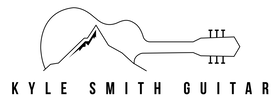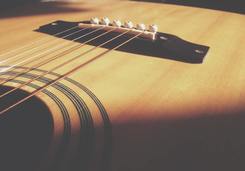 Playing chords is an essential part of playing guitar. No matter what kind of music you want to play - if you’re a guitar player, you’re going to spend a lot of time playing chords. It can be really helpful to focus on learning just a handful of chords at a time. You’ll learn the chords relatively quickly, avoid getting your chords mixed up, and be able to actually use your new chords to play songs as soon as you get comfortable with the shapes. The real trick is to learn chords that fit together in actual music, and are usually found together in songs. This way you can cut down the time between you learning your first chords, and you playing your first song. The truth is that many popular songs use just 3 or 4 related chords - so if you play your cards right, you can get away with learning just 3 or 4 chords to get started playing real songs. In this lesson you’re going to learn the 4 essential chords in the key of G:
What is a "key" anyway?A key is a group of notes or chords that sound good together. We don’t need to make it any more difficult than that. All major keys have 7 notes, with a chord built on top of each note. So in the key of G major, there are potentially 7 chords total that you could use. Within a key, the notes are numbered in alphabetical order, 1 through 7. there are also only 7 letters in our musical system, so each letter gets its own number within a key. More advanced musicians use this numbering system to keep track of chords in the songs they play. I’ve found that it’s just as easy for beginners to start doing this - especially if you make it a part of your practice from the beginning. Even though there are 7 possibilities, many popular songs only use 3 or 4 chords out of the key. The chords used are the 1, 4, 5, and 6 chords. Learning the chordsG ChordSince we are in the key of G, the G chord is going to get the number 1. You can think of this as the starting point, or home base for the key. 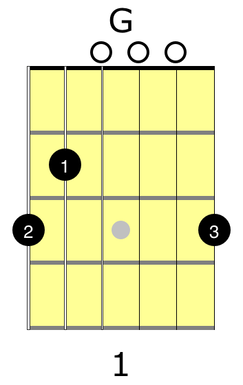 Finger Placement: - Ring finger (3) on the first string, third fret - Pointer finger (1) on the 4th string, second fret - Middle finger (2) on the 6th string, third fret Strumming: - You can strum all 6 strings Before You Move On: Practice this chord by itself before you try to learn another one. The goal is to get your fingers to be comfortable with where they need to go to form a G chord.
Repeat this process about 10 times. Focus on staying relaxed, and getting your fingers on the right spots. The chord will start to sound better as you get more comfortable with playing it. C ChordThe C chord is called the “4” chord in the key of G. If you think of the musical alphabet starting from G (G A B C D E F), C would be the fourth letter. 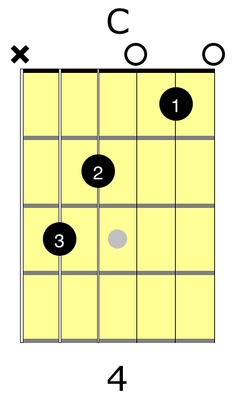 Finger Placement: - Pointer finger (1) on the second string, first fret - Middle finger (2) on the fourth string, second fret - Ring finger (3) on the fifth string, third fret Strumming: - Start your strum at the fifth string - Avoid playing all six strings if you can Before You Move On: Practice this chord by itself before you try to learn another one. The goal is to get your fingers to be comfortable with where they need to go to form a C chord.
Repeat this process about 10 times. Focus on staying relaxed, and getting your fingers on the right spots. The chord will start to sound better as you get more comfortable with playing it. Once you are comfortable, you can try to quiz yourself by switching between the G and C chords. Once again, try to stay relaxed as you play each chord. Make changing between chords feel easy. D ChordThe D chord is called the “5” chord in the key of G. If you think of the musical alphabet starting from G (G A B C D E F), D would be the fifth letter. 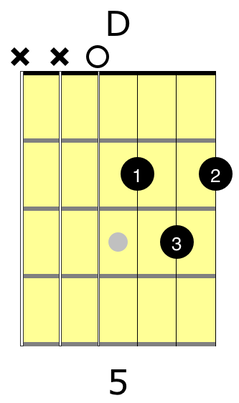 Finger Placement: - Middle finger (2) on the first string, second fret - Pointer finger (1) on the third string, second fret - Ring finger (3) on the second string, third fret Strumming: - Start your strum at the fourth string - Avoid playing the fifth and sixth strings if you can Before You Move On: Practice this chord by itself before you try to learn another one. The goal is to get your fingers to be comfortable with where they need to go to form a D chord.
Repeat this process about 10 times. Focus on staying relaxed, and getting your fingers on the right spots. The chord will start to sound better as you get more comfortable with playing it. Once you are comfortable, you can try to quiz yourself by switching between the G, C, and D chords. Try to stay relaxed as you play each chord. Make changing between chords feel easy. Em Chord (E minor)The Em chord is called the “6” chord in the key of G. If you think of the musical alphabet starting from G (G A B C D E F), E would be the sixth letter. In major keys, the 6 chord will usually be a minor chord. 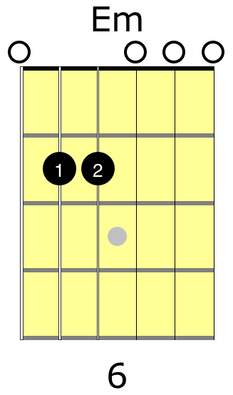 Finger Placement: - Pointer finger (1) on the fifth string, second fret - Middle finger (2) on the fourth string, second fret Strumming: - You can strum all 6 strings Before You Move On: Practice this chord by itself before you try to learn another one. The goal is to get your fingers to be comfortable with where they need to go to form a D chord.
Repeat this process about 10 times. Focus on staying relaxed, and getting your fingers on the right spots. The chord will start to sound better as you get more comfortable with playing it. Once you are comfortable, you can try to quiz yourself by switching between the G, C, D, and Em chords. Try to stay relaxed as you play each chord. Make changing between chords feel easy. Don’t worry too much about the order for now, just move from one chord to a different chord. Practicing Your New Guitar ChordsIt’s one thing to know what these chords look like and where to put your fingers, but another thing to be good at playing these chords. Practicing is what helps you take the information of where to put your fingers and what strings to play and program it into your hands so you can just play the chords that you want to play. We’re going to look at practicing these chords in two phases - I call them the mechanical phase, and the musical phase. Things To Think AboutBy only focusing on these 4 chords, you’ll be able to learn them quickly and use them in songs you want to play. You might be surprised how many songs you like actually use these exact chords.
Practice each chord on its own to build up your muscle memory, and when you’re comfortable, start to challenge yourself by changing from one chord to another. Soon you’ll be ready to start practicing chord progressions! Keep practicing these chords and if you have any questions, feel free to contact me here. I’m always happy to help! Ready to take your guitar playing further? Try a private guitar lesson today to get personalized instruction and coaching to help you reach your goals. Click here to learn more about how I can help you with guitar lessons.
0 Comments
Your comment will be posted after it is approved.
Leave a Reply. |
